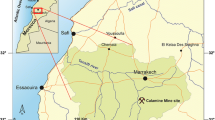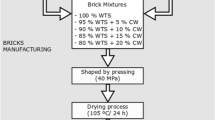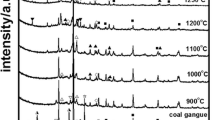Abstract
The most large-scale foundry waste is burnt molding earth, which is formed at the stage of knocking out castings from foundry molds. The properties of burnt molding earth (humidity, loss on ignition, elemental, phase, and grain composition) were studied and the possibility of its regeneration was confirmed. It is shown that during mechanical regeneration, about 24 wt.% of the considered waste turns into a fine pulverized fraction, which cannot be returned to the technological process and is sent to a landfill. On the basis of experimental studies, it has been established that this fraction of burnt molding earth can be used in the production of ceramic bricks as a lean additive. The obtained samples of ceramic bricks containing 20 wt.% finely dispersed fraction of molding burnt earth at a firing temperature of 1000 °C for 60 min are characterized by the following properties: average density 2020 kg/m3, water absorption 10.8%, compressive strength 39.8 MPa, and ultimate strength in bending 12.67 MPa.






Similar content being viewed by others
Data availability
All data employed in support to the outcomes in the study are included in this article.
References
Yefimenko N, Rajabzadeh M, Zaloga V, Fesenko D, Ryasnaya O (2023) A Universal Quality Control System on Machine-Building Enterprises. In: Grabchenko’s International Conference on Advanced Manufacturing Processes (pp. 391–399). Springer, Cham. https://doi.org/10.1007/978-3-031-16651-8_37
Iqbal MF, Liu QF, Azim I, Zhu X, Yang J, Javed MF, Rauf M (2020) Prediction of mechanical properties of green concrete incorporating waste foundry sand based on gene expression programming. J Hazard Mater 384:121322. https://doi.org/10.1016/j.jhazmat.2019.121322
Iqbal MF, Liu QF, Azim I (2019) Experimental study on the utilization of waste foundry sand as embankment and structural fill. In: IOP conference series: materials science and engineering (Vol. 474, No. 1, p. 012042). IOP Publishing. https://doi.org/10.1088/1757-899X/474/1/012042
Aftab B, Ok YS, Cho J, Hur J (2019) Targeted removal of organic foulants in landfill leachate in forward osmosis system integrated with biochar/activated carbon treatment. Water Res 160:217–227. https://doi.org/10.1016/j.watres.2019.05.076
Mymrin V, Ribas HE, Pedroso DE, Pedroso CL, Klitzke W, Avanci MA, Goncalves AJ, Rolim PH (2022) Physical–chemical processes of sustainable materials’ production from hazardous toner waste, galvanic glass waste and spent foundry sand. J Mater Cycles Waste Manage 25:396–406. https://doi.org/10.1007/s10163-022-01557-9
Akinwande AA, Balogun OA, Danso H, Romanovski V, Ademati AO, Oyediran AO (2023) Development of insulating masonry bricks from wood fiber and varying milled glass proportion. J Civil Eng Constr 12(1):40–54. https://doi.org/10.32732/jcec.2023.12.1.40
Barnabas AA, Balogun OA, Akinwande AA, Ogbodo JF, Ademati AO, Dongo EI, Romanovski V (2023) Reuse of walnut shell waste in the development of fired ceramic bricks. Environ Sci Pollut Res 30(5):11823–11837. https://doi.org/10.1007/s11356-022-22955-4
Abdulwahid MY, Akinwande AA, Kamarou M, Romanovski V, Al-Qasem IA (2023) The production of environmentally friendly building materials out of recycling walnut shell waste: a brief review. Biomass Convers Biorefinery. https://doi.org/10.1007/s13399-023-04760-2
Kamarou M, Moskovskikh D, Chan HL, Wang H, Li T, Akinwande AA, Romanovski V (2023) Low energy synthesis of anhydrite cement from waste lime mud. J Chem Technol Biotechnol 98:789–796. https://doi.org/10.1002/JCTB.7284
Romanovski V, Klyndyuk A, Kamarou M (2021) Green approach for low-energy direct synthesis of anhydrite from industrial wastes of lime mud and spent sulfuric acid. J Environ Chem Eng 9(6):106711. https://doi.org/10.1016/j.jece.2021.106711
Zalyhina V, Cheprasova V, Romanovski V (2022) Paper industry slag for the production of building ceramics. J Chem Technol Biotechnol 97(11):3091–3099. https://doi.org/10.1002/JCTB.7174
Romanovski V, Zhang L, Su X, Smorokov A, Kamarou M (2022) Gypsum and high quality binders derived from water treatment sediments and spent sulfuric acid: chemical engineering and environmental aspects. Chem Eng Res Des 184:224–232. https://doi.org/10.1016/j.cherd.2022.06.008
Kamarou M, Korob N, Hil A, Moskovskikh D, Romanovski V (2021) Low-energy technology for producing anhydrite in the CaCO3 – H2SO4 – H2O system derived from industrial wastes. J Chem Technol Biotechnol 96(7):2065–2071. https://doi.org/10.1002/jctb.6740
Romanovski V, Su X, Zhang L, Paspelau A, Smorokov A, Sehat AA, Akinwande AA, Korob N, Kamarou M (2023) Approaches for filtrate utilization from synthetic gypsum production. Environ Sci Pollut Res. https://doi.org/10.1007/s11356-022-24584-3
Akinwande AA, Folorunso DO, Balogun OA, Romanovski V (2022) Mathematical modelling, multi-objective optimization, and compliance reliability of paper-derived eco-composites. Environ Sci Pollut Res 29(1):70135–70157. https://doi.org/10.1007/s11356-022-20714-z
Akinwande AA, Balogun OA, Romanovski V (2022) Modeling, multi-response optimization, and performance reliability of green metal composites produced from municipal wastes. Environ Sci Pollut Res. https://doi.org/10.1007/s11356-022-20023-5
Ademati AO, Akinwande AA, Balogun OA, Romanovski V (2022) Optimization of bamboo-fiber-reinforced composite-clay bricks for development of low-cost farm-settlements towards boosting rural agri-business in Africa. J Mater Civ Eng 34(12):04022335. https://doi.org/10.1061/(ASCE)MT.1943-5533.0004489
Akinwande AA, Balogun OA, Romanovski V, Danso H, Kamarou M, Ademati AO (2022) Mechanical performance and Taguchi optimization of kenaf fiber/cement-paperboard composite for interior application. Environ Sci Pollut Res 29:52675–52688. https://doi.org/10.1007/s11356-022-19449-8
Akinwande AA, Balogun OA, Romanovski V, Ademati AO, Adetula YV (2022) Recycling of synthetic waste wig fiber in the production of cement-adobe for building envelope: physio-hydric properties. Environ Sci Pollut Res 29:34075–34091. https://doi.org/10.1007/s11356-022-18649-6
Zalyhina V, Cheprasova V, Romanovski V (2021) Pigments from spent chloride-ammonium zinc plating electrolytes. J Chem Technol Biotechnol 96(10):2767–2774. https://doi.org/10.1002/jctb.6822
Zalyhina V, Cheprasova V, Belyaeva V, Romanovski V (2021) Pigments from spent Zn, Ni, Cu, and Cd electrolytes from electroplating industry / Environmental Science and Pollution. Research 28:32660–32668. https://doi.org/10.1007/s11356-021-13007-4
Martsul VN, Zalygina OS, Shibeka LA, Likhacheva AV, Ramanouski VI (2012) Some applications of galvanic manufacture waste/Proceedings of BSTU. Chemistry and technology of inorganic substances. Vol. 3, pp 66–70
Martsul VN, Likhacheva AV, Shibeka LA, Zalygina OS, Ramanouski VI, Khodin VV (2012) Inventory of galvanic sludge and deposits of the treatment facilities formed at the enterprises of the Republic of Belarus. In: Proceedings of BSTU. Chemistry and technology of inorganic substances. 3; pp 71–77
Martsul VN, Zalygina OS, Likhacheva AV, Romanovski VI (2013) Treatment of electroplating shop wastewater at enterprises of the Republic of Belarus. In: Proceedings of BSTU. Chemistry and technology of inorganic substances. Vol. 3, pp 57–62
Matsukevich I, Kulinich N, Romanovski V (2022) Direct reduced iron and zinc recovery from electric arc furnace dust. J Chem Technol Biotechnol 97(11):3091–3099. https://doi.org/10.1002/jctb.7205
Hurynovich A, Kwietniewski M, Romanovski V (2021) Evaluation of the possibility of utilization of sewage sludge from Wastewater Treatment Plant – case study. Desalin Water Treat 227:16–25. https://doi.org/10.5004/dwt.2021.27199
Smorokov A, Kantaev A, Bryankin D, Miklashevich A, Kamarou M, Romanovski V (2023) Low-temperature method for desiliconization of polymetallic slags by ammonium bifluoride solution. Environ Sci Pollut Res 30(5):30271–30280. https://doi.org/10.1007/s11356-022-24230-y
Smorokov A, Kantaev A, Bryankin D, Miklashevich A, Kamarou M, Romanovski V (2023) A novel low-energy approach of leucoxene concentrate desiliconization by ammonium bifluoride solutions. J Chem Technol Biotechnol 98(3):726–733. https://doi.org/10.1002/jctb.7277
Smorokov A, Kantaev A, Bryankin D, Miklashevich A, Kamarou M, Romanovski V (2022) Low-temperature desiliconization of activated zircon concentrate by NH4HF2 solution. Miner Eng 189:107909. https://doi.org/10.1016/j.mineng.2022.107909
Sithole NT, Tsotetsi NT, Mashifana T, Sillanpää M (2022) Alternative cleaner production of sustainable concrete from waste foundry sand and slag. J Clean Prod 336:130399. https://doi.org/10.1016/j.jclepro.2022.130399
Priyadarshini M, Giri JP (2022) Use of recycled foundry sand for the development of green concrete and its quantification. J Build Eng 52:104474. https://doi.org/10.1016/j.jobe.2022.104474
Cunha S, Costa D, Aguiar JB, Castro F (2023) Mortars with the incorporation of treated ceramic molds shells wastes. Constr Build Mater 365:130074. https://doi.org/10.1016/j.conbuildmat.2022.130074
Gautam L, Jain JK, Jain A, Kalla P (2022) Valorization of bone-china ceramic powder waste along with granite waste in self-compacting concrete. Constr Build Mater 315:125730. https://doi.org/10.1016/j.conbuildmat.2021.125730
Schwarz M, Salva J, Vanek M, Poništ J, Prepilková V, Lobotková M, Turčániová E (2022) Assessment of possibilities of using waste foundry sand–review. Int J Mater Res 1:1
Cioli F, Abbà A, Alias C, Sorlini S (2022) Reuse or disposal of waste foundry sand: an insight into environmental aspects. Appl Sci 12(13):6420. https://doi.org/10.3390/app12136420
Anjum F, Naz MY, Ghaffar A, Kamran K, Shukrullah S, Ullah S (2022) Sustainable insulating porous building materials for energy-saving perspective: stones to environmentally friendly bricks. Constr Build Mater 318:125930. https://doi.org/10.1016/j.conbuildmat.2021.125930
Filippenkov AA, Maizel SG, Afonaskin AV, Churkin BS, Hoffman EB, Churkin AB, Kategorenko A, Yu I (Ed.) Milyaev VM (Ed.) (2018). Foundry technology: textbook. (2nd ed., revised and supplemented ed.) Russian State Vocational Pedagogical University. ISBN 978–5–8050–0641–9
Quijorna N, Coz A, Andres A, Cheeseman C (2012) Recycling of Waelz slag and waste foundry sand in red clay bricks. Resour Conserv Recycl 65:1–10. https://doi.org/10.1016/j.resconrec.2012.05.004
Alonso-Santurde R, Andrés A, Viguri JR, Raimondo M, Guarini G, Zanelli C, Dondi M (2011) Technological behaviour and recycling potential of spent foundry sands in clay bricks. J Environ Manage 92(3):994–1002. https://doi.org/10.1016/j.jenvman.2010.11.004
Alonso-Santurde R, Coz A, Viguri JR, Andrés A (2012) Recycling of foundry by-products in the ceramic industry: green and core sand in clay bricks. Constr Build Mater 27(1):97–106. https://doi.org/10.1016/j.conbuildmat.2011.08.022
Hossiney N, Das P, Mohan MK, George J (2018) In-plant production of bricks containing waste foundry sand—a study with Belgaum foundry industry. Case Stud Constr Mater 9:e00170. https://doi.org/10.1016/j.cscm.2018.e00170
Funding
The authors received no funding from any source.
Author information
Authors and Affiliations
Contributions
VZ: Conceptualization. Formal analysis. Investigation. Methodology. Resources. Supervision. Data curation. Validation. Writing—original draft. Writing—review and editing; VC: Formal analysis. Investigation. Data curation. Validation; VR: Formal analysis. Data curation. Validation. Visualization. Writing—original draft. Writing—review and editing.
Corresponding authors
Ethics declarations
Conflict of interest
The authors declare no competing interest with any previous work.
Ethics approval and consent to participate
Not applicable.
Consent for publication
Not applicable.
Additional information
Publisher's Note
Springer Nature remains neutral with regard to jurisdictional claims in published maps and institutional affiliations.
Rights and permissions
Springer Nature or its licensor (e.g. a society or other partner) holds exclusive rights to this article under a publishing agreement with the author(s) or other rightsholder(s); author self-archiving of the accepted manuscript version of this article is solely governed by the terms of such publishing agreement and applicable law.
About this article
Cite this article
Zalyhina, V., Cheprasova, V. & Romanovski, V. Recycling of fine fraction of spent foundry sands into fireclay bricks. J Mater Cycles Waste Manag 26, 322–330 (2024). https://doi.org/10.1007/s10163-023-01825-2
Received:
Accepted:
Published:
Issue Date:
DOI: https://doi.org/10.1007/s10163-023-01825-2




